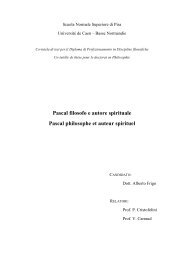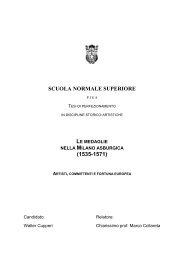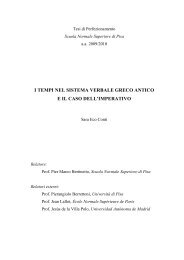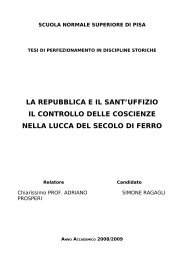CATULLUS 68 - Scuola Normale Superiore
CATULLUS 68 - Scuola Normale Superiore
CATULLUS 68 - Scuola Normale Superiore
Create successful ePaper yourself
Turn your PDF publications into a flip-book with our unique Google optimized e-Paper software.
The parallels guarantee that the transmitted phrase is correct, and the conjectures that have been proposed are<br />
not particularly convincing: Nicolaus Heinsius’ conjecture cinere would fit badly with torruerit, while<br />
Schrader’s uenere would be odd after Amathusia.<br />
torruerit All the MSS that I know of read corruerit, while torruerit was found by Santenius in two codices<br />
and is defended by Turnebus. Here most editors print torruerit; only Kroll writes corruerit, but he proceeds<br />
to comment that torruerit does, after all, seem more likely. torruerit is plausible (Baehrens rightly notes that<br />
c and t are often exchanged for one another; they resemble each other very closely in Gothic minuscule), but<br />
is it necessary?<br />
corruerit would be a transitive use of corruo, unusual but attested, especially in archaic or archaizing<br />
contexts: compare Plautus Rud. 542 ibi me conruere posse aiebas ditias, Varro L.L. 5.139 corbes ab eo quod<br />
eo spicas aliudue quid corruebant (he is reconstructing an earlier usage), Lucr. 5.367f. quae possint ... /<br />
corruere hanc rerum uiolento turbine summam, Apul. Met. 8.8 Charite ... uelut graui tonitru ... percussa<br />
corruit corpus et obnubilauit animam (see Hijmans & al. 1985 ad loc.) and also Iulianus Aeclanensis<br />
(Pseudo-Rufinus) in Osee 6.8f. = 2 29 r in sacrilegio corruendo. Elsewhere Catullus uses the verb once at the<br />
very most, and intransitively, at 66.93, where Lachmann’s proposal corruerint for A’s cur iterent is possible,<br />
but so is Pontanus’ cur retinent. Here the problem with corruerit is that it means the wrong thing: much<br />
though Venus may have tormented Catullus, she did not destroy him or incapacitate him in any way.<br />
torruerit, on the other hand, would refer to scorching, an activity proper to the forces of love in Catullus<br />
(compare 100.7 cum uesana meas torreret flamma medullas) and elsewhere (Hor. Od. 4.1.12 si torrere iecur<br />
quaeris idoneum, to Venus; also ibid. 1.33.6, 3.9.13, 3.19.28; Prop. 3.24.13 correptus saeuo Veneris torrebar<br />
aeno; Ov. Am. 3.2.40; OLD s.v. 2b). Also, it would neatly anticipate the fire imagery in the following distich.<br />
I am confident that it is correct.<br />
53f. ‘When I was burning as much as Mount Etna and the hot springs of Thermopylae’: Catullus compares<br />
his ardent passion to two well-known natural phaenomena. The exaggeration inherent in the comparison is<br />
characteristic of Catullus at his most passionate.<br />
The similes are cast in suitably recherché language: one should note the circumlocution Trinacria rupes and<br />
the accumulation of Greek and Grecizing words in line 54.<br />
53 arderem ardeo is first used for amorous passion by Catullus (see further TLL 2.485.20-67), and he is<br />
rather fond of this root: note 2.8 credo, ut tum grauis acquiescat ardor, 45.15f. multo mihi maior acriorque /<br />
ignis mollibus ardet in medullis and 62.23 iuueni ardenti castam donare puellam.<br />
Trinacria rupes ‘The Trinacrian cliff’ is a learned circumlocution for Mount Etna on Sicily, one of the<br />
best-known volcanoes of the Mediterranean. Trinacrius is a calque of the Greek adjective Τριν κριο!,<br />
which comes from Τρινακρ⇔α, which is mentioned already by Thucydides 6.2.2 as an ancient name for the<br />
triangular island Sicily (it appears to have arisen through popular etymology from Ψρινακ⇔η, the name of<br />
166






